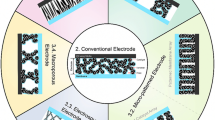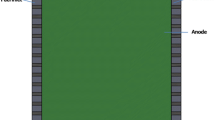Abstract
A 2D axisymmetric electrochemical model of a lithium experimental cell is solved using a finite element method. The model is considering the coupled effect of momentum, electric, kinetic and mass transfer phenomena. The dense diaphragm used in the setup, which is not hydraulically permeable, separates the cell into two regions: 1 (a) turbulent region, between the anode and the diaphragm, and 2 (a) laminar region between the diaphragm and the cathode. The k-epsilon model is used to solve the turbulent flow resulting from bubbles generation at the anode. A two-phase flow model is also developed to simulate the volume fractions of bubbles and electrolyte in the cell. The non-uniform bubbles distribution over the anode surface, derived from the non-uniform current distribution, has been added to the two-phase model. The effects of the diaphragm length, position and porosity on the electric and two-phase flow fields are simulated. In fact, the diaphragm position and length both influence the current distribution at the surface of electrodes and the velocity distribution in the cell, all of which influence ohmic and kinetic overpotentials. The results show that up to 40% of energy can be saved when running the lithium electrolysis cell with a shorter porous diaphragm located as far as possible from the anode. The maximum current density, found at the bottom corner of anode, is higher when the diaphragm is longer and when it is closer to the anode.
Graphical Abstract














Similar content being viewed by others
Abbreviations
- A:
-
Area (m2)
- CD :
-
Drag coefficient
- c:
-
Concentration (mol m−3)
- Deff :
-
Effective diffusion coefficient (m2 s−1)
- db :
-
Bubble diameter (m)
- F:
-
Faraday’s constant (A s mol−1)
- Fb :
-
Volume force (kg m s−2)
- FD :
-
Drag force (kg m s−2)
- g:
-
Gravity acceleration constant (m s−2)
- i:
-
Local current density (A m−2)
- i0 :
-
Exchange current density (A m−2)
- k:
-
Turbulent kinetic energy (m2 s−2)
- L:
-
Length (m)
- M:
-
Molecular weight (kg mol−1)
- N:
-
Ions flux (mol m−2 s−1)
- N:
-
Normal vector
- p:
-
Pressure (kg m−1 s−2)
- R:
-
Gas constant (J K−1 mol−1)
- Re:
-
Reynolds number
- T:
-
Temperature (K)
- \({\text{T}}_{{\text{k}}}^{{{\text{turb}}}}\) :
-
Stress tensor (kg m−1 s−2)
- t:
-
Time (s)
- u:
-
Velocity magnitude (m s−1)
- um :
-
Mobility (m2 s−1 V−1)
- ut :
-
Bubbles terminal velocity (m s−1)
- V:
-
Velocity vector (m s−1)
- x:
-
Mole fraction
- z:
-
Charge number
- α0 :
-
Transfer coefficient
- σ:
-
Electrolyte conductivity (S m−1)
- \(\epsilon\) :
-
Rate of dissipation of kinetic energy (m2 s−3)
- ε:
-
Porosity
- \({{{\upeta}}}\) :
-
Activation overpotential (V)
- µ:
-
Viscosity (kg m−1 s−1)
- \({{{\uprho}}}\) :
-
Density (kg m−3)
- τ:
-
Tortuosity
- φ:
-
Volume fraction
- \({\emptyset _{\text{g}}}\) :
-
Bubble coverage
- a:
-
Anode
- c:
-
Continuous phase
- d:
-
Disperse phase
- dia:
-
Diaphragm
- i:
-
Species i
- in:
-
Inlet
- h:
-
Hyperpolarization
- mean:
-
Mean
- mix:
-
Resistive layer
- T:
-
Turbulent
References
James CD (1924) Electrolytic process and cell. US Patent 1,501,756
Muller J, Bauer R, Sermond B, Dolling E (1988) Process and apparatus for producing high-purity lithium metal by fused-salt electrolysis. US Patent 4,740,279
Verdier JM, Jacubert S, Grosbois J, Dumousseau JY (1986) Continuous electrolysis of lithium chloride into lithium metal. US Patent 4,617,098
Nakamura E, Takata H, Yokoyama Y, Miyamoto H (2010) Process for producing metallic lithium. US Patent 20,100,051,470
Le Roux E, Nataf P, Jacubert S (1988) Continuous production of lithium metal by electrolysis of lithium chloride. US Patent 4,724,055
Bergmann OR, Blank HM, Diemer RB et al (2000) Modified electrolyte and diaphragm for fused salt electrolysis. US Patent 6,063,247
Blank HM, Bergmann OR, Simmons WJ (1999) Fused chloride salt electrolysis cell. US Patent 5,904,821
Li D, Chattopadhyay K, Gao L, Davis B, Schwarze R, Asad A, Kratzsch C (2017) Mathematical modeling of molten salt electrolytic cells for sodium and lithium production. Applications of process engineering principles in materials processing, energy and environmental technologies. Springer, New York, pp 129–138
Oliaii E, Désilets M, Lantagne G (2017) Numerical analysis of the effect of structural and operational parameters on electric and concentration fields of a lithium electrolysis cell. J Appl Electrochem 47(6):711–726
Amouzegar K, Harrison S (1996) Electrolytic production of lithium metal. Report, HydroQuebec, Shawinigan
Thonstad J, Fellner P, Haarberg GM, Híves J, Kvande H, Sterten A (2001) Aluminium electrolysis: fundamentals of the Hall-Héroult process. Aluminium-Verlag, Dusseldorf
Vogt H, Balzer RJ (2005) The bubble coverage of gas-evolving electrodes in stagnant electrolytes. Electrochim Acta 50(3):2073–2079
Vogt H (2011) On the gas-evolution efficiency of electrodes. II: Numerical analysis. Electrochim Acta 56:2404–2410
Liu C-L, Sun Z, Lu G-M, Song X-F, Yu J-G (2015) Experimental and numerical investigation of two-phase flow patterns in magnesium electrolysis cell with non-uniform current density distribution. Can J Chem Eng 93(3):565–579
Aldas K, Pehlivanoglu N, Mat MD (2008) Numerical and experimental investigation of two-phase flow in an electrochemical cell. Int J Hydrog Energy 33(14):3668–3675
Taylor R, Krishna R (1993) Multicomponent mass transfer. vol 2., Wiley, New York, p 243
Nelissen G, Van Den Bossche B, Deconinck J, Van Theemsche A, Dan C (2003) Laminar and turbulent mass transfer simulations in a parallel plate reactor. J Appl Electrochem 33(10):863–873
Calmet I, Magnaudet J (1997) Large-eddy simulation of high-schmidt number mass transfer in a turbulent channel flow. Phys Fluids 9(2):438–455
Lyons SL, Hanratty TJ, McLaughlin JB (1991) Large-scale computer simulation of fully developed turbulent channel flow with heat transfer. Int J Numer Methods Fluids 13(8):999–1028
Tjaden B, Cooper SJ, Brett DJ, Kramer D, Shearing PR (2016) On the origin and application of the Bruggeman correlation for analysing transport phenomena in electrochemical systems. Curr Opin Chem Eng 12:44–51
Chung DW, Ebner M, Ely DR, Wood V, García RE (2013) Validity of the Bruggeman relation for porous electrodes. Model Simul Mater Sci Eng 21(7):74009
Ebner M, Wood V (2015) Tool for tortuosity estimation in lithium ion battery porous electrodes. J Electrochem Soc 162(2):A3064–A3070
Díaz ME, Iranzo A, Cuadra D, Barbero R, Montes FJ, Galán MA (2008) Numerical simulation of the gas-liquid flow in a laboratory scale bubble column. Influence of bubble size distribution and non-drag forces. Chem Eng J 139(2):363–379
Alexiadis A, Dudukovic M, Ramachandran P, Cornell A, Wanngård J, Bokkers A (2011) On the electrode boundary conditions in the simulation of two phase flow in electrochemical cells. Int J Hydrogen Energy 36:8557–8559
Oldham K, Myland J, Bond A (2011) Electrochemical science and technology: fundamentals and applications. Wiley, New York
Acknowledgements
The authors wish to thank Dr. Kamyab Amouzegar for his useful suggestions. We also appreciate Hydro-Québec for their financial support, for providing us with the experimental results and giving us the opportunity to publish this work. The authors are also grateful to the Natural Sciences and Engineering Council of Canada (NSERC) for its financial support.
Author information
Authors and Affiliations
Corresponding author
Rights and permissions
About this article
Cite this article
Oliaii, E., Désilets, M. & Lantagne, G. Effect of the design parameters on mass transfer and energy consumption inside a lithium electrolysis cell. J Appl Electrochem 48, 725–737 (2018). https://doi.org/10.1007/s10800-018-1179-1
Received:
Accepted:
Published:
Issue Date:
DOI: https://doi.org/10.1007/s10800-018-1179-1




